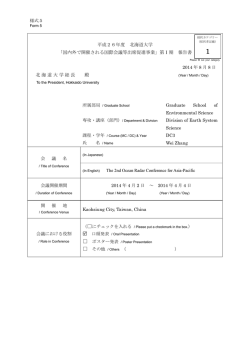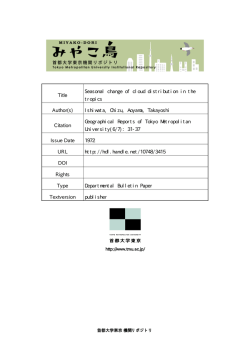
DONET で観測された海洋重力波が励起される方向と季節変化 Source
DONET で観測された海洋重力波が励起される方向と季節変化 東野陽子 1, 西田究 2, 深尾良夫 1, 藤亜希子 1, 髙橋成実 1 1 海洋研究開発機構 2 東大地震研究所 Source direction and seasonable variations of ocean infragravity waves incoming to the Japanese seafloor network, DONET Yoko Tono1, Kiwamu NIshida2, Yoshio Fukao1, Akiko To1, Narumi Takahasi1 1 JAMSTEC 2 ERI Ocean infragravity (IG) waves are sea-surface gravity waves with periods of several minutes and wavelengths of tens of kilometers. Phase velocity of IG wave observed in deep ocean environments is accurately explained by the gravity-wave theory. These waves are considered to be excited by non-linear interactions between oceanic swells,the Earth’s hum, and may be enhanced by tidal modulation in coastal ocean areas and deep-sea envirements. By using a slant-stack technique, we detected ocean infragravity (IG) waves (40–200 s within the period) from the three-year period records (2011–2013) of the vertical component broadband seismograms and pressure gauges of the Dense Oceanfloor Network System for Earthquakes and Tsunamis (DONET) in the Nankai Trough region. The signal intensities are strongly azimuth-dependent. Except in the case of extreme weather, waves incoming from the two closely adjacent directions, 140-160º (SSE) and 110-130º (ESE), are overwhelming. This does not necessarily mean that IG waves are generated everywhere in the ocean. The identified sources are rather localized and remain geographically stationary but show seasonally varying intensities of strong in winter and weak in summer. IG waves incoming from the shallower ocean in the ESE are more dominant in the shorter-period component than those from the deeper ocean in the SSE. Besides these two stationary sources, IG waves can be generated sporadically by typhoons. The incoming direction of the typhoon-originated IG waves depends in a seemingly complex way on the past track of the moving typhoon. The enhanced IG waves are often more energetic than those directly from the source region. A typhoon to the south far from the network always enhances IG waves incoming from the NE to the ENE direction. This observation may provide an understanding of the process in which IG waves are generated. The observations of IG waves at the bottom of Arctic Ocean should be possible to detect the phenomena related to Arctic Ocean circulation. Fig. 1) Distribution of Dense Oceanfloor Network System for Earthquake and Tsunamis (DONET) stations and submarine topography. The color contour is consistent with the marine depth. The black circles show the stations. The A, B, D, and E nodes are located at a depth of approximately 2000 m, whereas the C-node is located approximately 4000 m deep. The square indicates the midpoint of the array of all the stations of the A, B, D, and E nodes. The two gray and black lines show the azimuthal windows of 110°–130° (east–southeast) and 140°–160° (south–southeast), respectively.
© Copyright 2025


